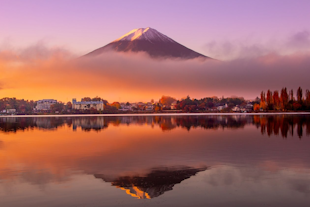
Reasons To Visit Japan
Scenery, culture and cuisine beyond measure



Nestled on the northern island of Hokkaido, Akan-Mashu National Park is a spectacular vision of volcanic hot springs, pristine forests, and crystal-clear lakes. This untouched wilderness is home to the magnificent Lake Akan, famous for its marimo (algae balls) and breathtaking vistas. The park offers a whole host of outdoor activities such as hiking, canoeing, and winter sports, alongside opportunities to immerse yourself in the culture of the indigenous Ainu people. From the mysterious, fog-laden Lake Mashu to the active volcanoes that shape this landscape, Akan-Mashu is a testament to nature's artistry and power.
Start with a recommended trip or create one from scratch
Nestled in eastern Hokkaido, Akan-Mashu National Park dazzles visitors with its volcanic showstoppers and crystalline caldera lakes. At Lake Akan, you'll find the peculiar marble-like marimo algae balls, while the perpetually misty Lake Mashu boasts water clarity that borders on the supernatural. Adventurous souls can tackle Mount Meakan's steaming slopes or wander the otherworldly sulfur vents of Mount Iō. After working up a sweat, sink into one of Kussharo's free lakeside hot springs – nothing beats soaking while gazing over Japan's largest caldera lake. Culture vultures shouldn't miss Ainu Kotan, Hokkaido's largest indigenous settlement, where traditional performances bring ancient customs to life. Winter transforms the landscape entirely, offering rare chances to walk atop crackling drift ice. Whether you're driving the jaw-dropping Bihoro Pass or simply watching steam rise from volcanic vents, Akan-Mashu delivers a slice of Japan that feels almost extraterrestrial in its raw, untamed beauty.
/144.1001780513723,43.454731688641104,3/600x400?access_token=pk.eyJ1IjoidGltYnVrdHV0cmF2ZWwiLCJhIjoiY2poMGw1eHpkMmRkbDJ6bW8xYWZ5OGpjYyJ9.PYvAO7lUJ40SOpGvwmQLqw&attribution=false&logo=false)
The beauty of its lakes, whether you watch rare marimo 'colonies' in their natural habitat at Lake Akan, or soak in the ethereal scenes of Lake Mashu, one of the clearest lakes in the world.
Trek to the lesser-known Mount Io, an active volcano where the ground breathes smoke, offering a unique and raw glimpse into Earth’s inner workings.
The region's weather can be unpredictable and some trails may be closed in winter months. Planning your visit according to the seasons and checking local conditions prior to any excursions can enhance your experience.
Jan
Feb
Mar
Apr
May
Jun
Jul
Aug
Sep
Oct
Nov
Dec
Dry Season
Dry Season
Dry Season
Dry Season
Dry Season
Wet Season
Wet Season
Wet Season
Dry Season
Dry Season
Dry Season
Dry Season